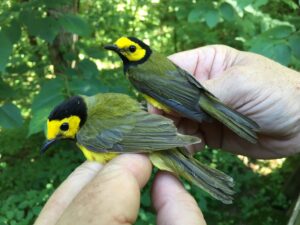By Bernheim

Birds are probably the animals we encounter most in our lives. A glance out the window or a short drive will almost certainly provide sightings of multiple birds. If you don’t see them, you probably hear them. Unfortunately, these encounters are becoming less frequent according to recent study by Cornell University, which claims that the bird population has declined by as many as 3 billion birds in the past 50 years. This data comes from bird counts and radar data that shows birds across the globe have declined significantly. You can view the study by clicking here.
Bernheim has a 90-year history of bird conservation work, including educational hikes and programs, bird surveys and counts documenting 229 species, golden eagle research and tracking, bird reintroductions for turkey and quail, and most recently songbird tracking with LifeTags™ in collaboration with Motus. Our key partners in this research are Cellular Tracking Technologies and the Office of Kentucky Nature Preserves.

Motus Bird Tracking is receiving increasing interest from the birder community. In addition to funds already raised in honor of Judge Boyce Martin, Jr., we gained generous support from additional individual contributions and the KY Audubon Society last week, which are helping us successfully continue this project. We had a great conference call with partners in Tennessee that are working to install a network of Motus receivers and towers. Building out the infrastructure across the Mississippi and Ohio Valley will be a critical component to understanding migrations and movements.
We want to announce some dates for our birds tracked with LifeTags during summer. We installed 12 LifeTags in summer, 2019 focusing on five species of Neotropical migrants: Purple Martin, Kentucky Warbler, Wood Thrush, Indigo Bunting, and Louisiana Waterthrush. These birds were selected because they represent some of Bernheim’s most charismatic breeders, are members of the “Partners in Flight” watchlist and are species of greatest conservation need. In the first season of deployment, we fitted 6 Louisiana Waterthrush, 6 Purple Martin, 1 Kentucky Warbler, and 1 Wood Thrush with cutting-edge CTT LifeTag transmitters.
Data collected by Bernheim towers show that the birds were last detected on:
Kentucky Warbler- August 30, 2019
Louisiana Waterthrush- October 4, 2019
Wood Thrush- September 15, 2019
Purple Martin- August 15, 2019

These dates may indicate when they began migration south towards their winter range. If they return to Bernheim in the spring, we hope to be able to detect their arrival. The Purple Martin is a great control for this research, as they will return to the Bernheim Education Center in spring and are easily observable to check the timing of their arrival.
This research is ongoing and holds much potential for understanding details of migration and habitat requirements, but we have lots of work to do before we unravel the reasons behind bird declines and find lasting solutions. Until then, Bernheim will continue to do what we can to protect and manage habitats for our birds, and work with the larger bird community on research, education, and outreach around these incredible animals. Stay tuned as this exciting research grows during 2020!

